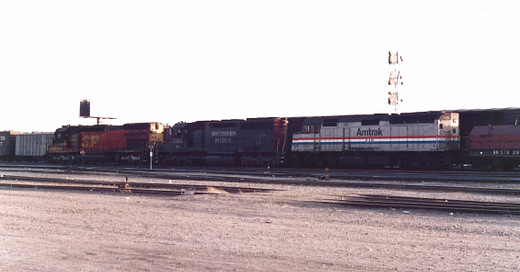Commentary: Most Efficient, Least Utilized: Trains

The dichotomy that trains are the most efficient, yet the least utilized of the automated-transport-and-travel-options available is not some obscure fact tucked away in some manila folder locked inside some file cabinet somewhere. This is common knowledge; a widely known fact, in fact. Though the following is dated, is less widely known and, in my view, something the interested observer should never lose sight of due to its relevancy, but according to city planner and book author Jeff Speck, of all trips taken in the United States in 2012, only 1.5 percent were on public transportation.[1] And now, just 13 years later and as if to be adding injury to insult, we find that trains make up just two percent of transportation-sector activities worldwide. We can — and should — do better.
The Race To The Top
There has been quite a push in the last decade to make the surface transport sector more and more automated. The impetus driving this is to not only make land-based transport — and travel — more efficient, but make the realm safer and less polluting. All of which is quite laudable.
Only the question no one seems to be able to answer definitively is how fast an all-encompassing program can be rolled out. No matter when asked, the recurring response always seems to be: “In decades”.
Another question: Can we afford to wait decades?, especially considering the unknown here is whether or not universal autonomobility (fully driverless operation) is even a reachable outcome. From everything I’ve read on the matter, the consensus seems to be that it is. I know this is the expectation anyway. That reality is far and away different than that of absolutism, meaning universal autonomobility that’s assured or guaranteed.
Perhaps the really practical solution has been under our noses all along. That solution? Trains.
So, how can it be known which approach is the correct one, or in the event there is no one right way, then at least the one that makes (or the ones that make) the most sense?
Daniel Sperling, Distinguished Blue Planet Prize Professor of Engineering and Environmental Science & Policy at the University of California, Davis, in “Driver’s seat: The down-the-road view,”[2] offered further perspective.
Sperling wrote, in part:
“If AVs (aka autonomous vehicles) are personally owned and simply replace human-driven vehicles, it will be a disaster—with a huge increase in vehicle use since they will encourage people to [live] farther from work, and to use their vehicles as offices, hotels, and entertainment centers. But if the vehicles are operated as pooled transit vehicles and thereby carry multiple passengers, then the result would be a large reduction in vehicle use and ownership. The service would be so inexpensive and convenient that most travelers would be delighted to relinquish the hassles—and costs—of driving, parking, maintenance, and repair. But will people be willing to share rides and will cities be willing to embrace driver-less vehicles?”
A huge unknown.
Meanwhile, On The Plus Side
The one “for sure” is that trains work. They’ve proven their worth over the short, medium and long hauls, time and time again.
It’s a well-established fact China has built out its high-speed-rail network to the tune of at least 25,000 miles. Indeed a positive sign!
Furthermore, according to information found in a study conducted by Hitachi, is: “A significant new study, published by Hitachi Rail, has found that citizens around Europe and North America anticipate train travel to soar in the coming years at the expense of flying. Almost two-thirds also back legislation to enforce this change, supporting a ban on short-haul flights where high speed rail alternatives exist.”*
“Edoardo La Ficara, Group Chief Markets Officer, Hitachi Rail, said:”
The findings of this research are strikingly clear. Those surveyed expect to increase their rail usage more than any other form of transport in the next five years and they support Government action to enable this. We, as an industry, have a crucial opportunity to meet this public demand by delivering a great sustainable mobility transition.
“The research also explored how to grow public transport usage, with passengers identifying crowding, affordability and convenience as the biggest challenges. Across all countries, over seven in ten said they would use public transport more if it were better connected, and this remained at over half even if it cost more.”
It should be noted that the sample size of the survey (conducted by SavantaComres) was 11,000 people total from a mix of countries including from France, Germany, Italy, Spain, the U.K. and the U.S.
All things considered so far, trains, for my money are still the best thing “going” … and coming!
* To learn more, see: “In Next Five Years, Rising EU, US Long-distance Train Travel Expected,” a May 19, 2025 All About Trains “News” item. Representative URL: https://allabouttrains.substack.com/p/in-next-five-years-rising-eu-us-long
Notes
Jeff Speck, Walkable City: How Downtown Can Save America One Step At A Time, North Point Press, 2012, p. 141
Alan Kandel, “Driver’s seat: The down-the-road view,” The Daily Kos, Sept. 11, 2023. https://www.dailykos.com/stories/2023/9/11/2192633/-Driver-s-seat-The-down-the-road-view
Updated: Jun. 29, 2025 at 1:02 p.m. PDT.
All material copyrighted 2025, Alan Kandel. All Rights Reserved.



